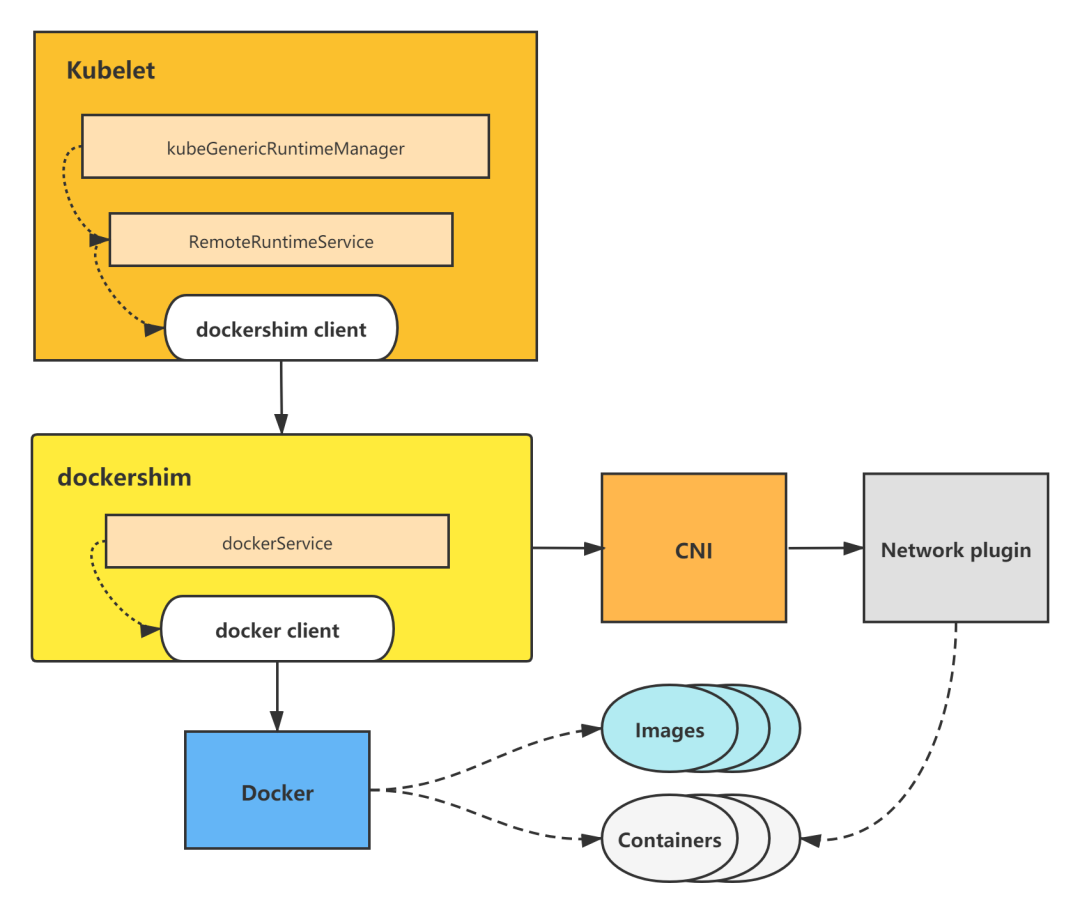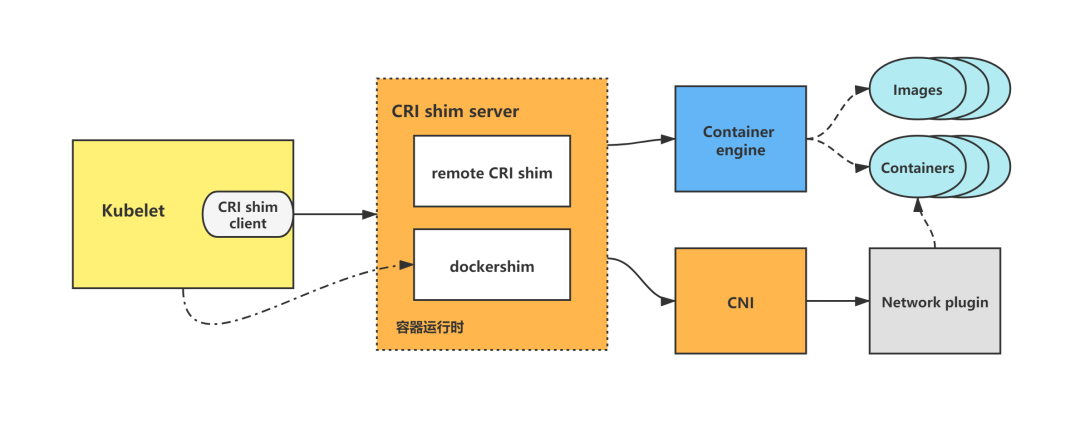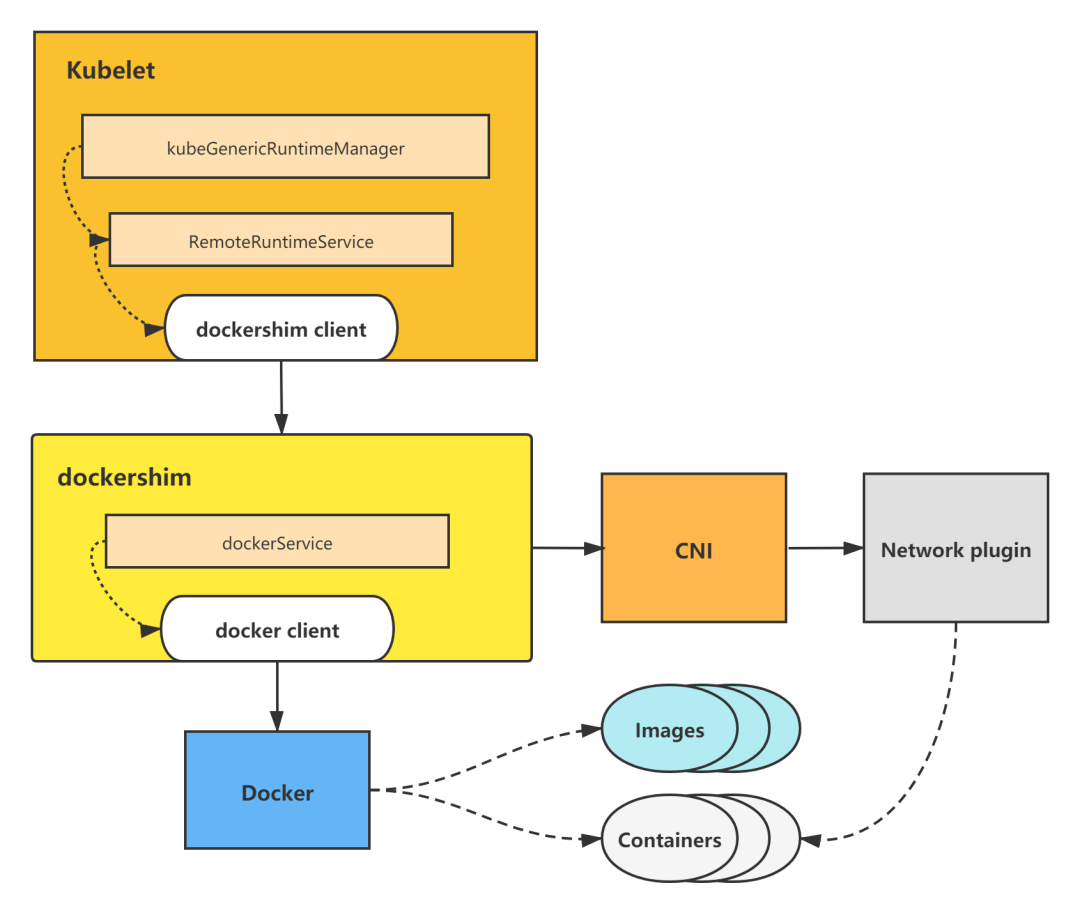Kubernetes CRI 分析 - kubelet 创建 Pod 分析
作者:良凯尔,云原生爱好者,目前在某互联网大厂,主要负责 Kubernetes 相关的研发工作。
kubelet CRI 创建 Pod 调用流程
下面以 kubelet dockershim 创建 Pod 调用流程为例做一下分析。
kubelet 通过调用 dockershim 来创建并启动容器,而 dockershim 则调用 Docker 来创建并启动容器,并调用 CNI 来构建 Pod 网络。

dockershim 属于 kubelet 内置 CRI shim,其余 remote CRI shim 的创建 Pod 调用流程其实与 dockershim 调用基本一致,只不过是调用了不同的容器引擎来操作容器,但一样由 CRI shim 调用 CNI 来构建 Pod 网络。
下面开始详细的源码分析。
直接看到 kubeGenericRuntimeManager 的 SyncPod 方法,调用 CRI 创建 Pod 的逻辑将在该方法里触发发起。
从该方法代码也可以看出,kubelet 创建一个 Pod 的逻辑为:
先创建并启动 Pod sandbox 容器,并构建好 Pod 网络; 创建并启动 ephemeral containers; 创建并启动 init containers; 最后创建并启动 normal containers(即普通业务容器)。
这里对调用 m.createPodSandbox 来创建 Pod sandbox 进行分析,m.startContainer 等调用分析可以参照该分析自行进行分析,调用流程几乎一致。
// pkg/kubelet/kuberuntime/kuberuntime_manager.go
// SyncPod syncs the running pod into the desired pod by executing following steps:
//
// 1. Compute sandbox and container changes.
// 2. Kill pod sandbox if necessary.
// 3. Kill any containers that should not be running.
// 4. Create sandbox if necessary.
// 5. Create ephemeral containers.
// 6. Create init containers.
// 7. Create normal containers.
func (m *kubeGenericRuntimeManager) SyncPod(pod *v1.Pod, podStatus *kubecontainer.PodStatus, pullSecrets []v1.Secret, backOff *flowcontrol.Backoff) (result kubecontainer.PodSyncResult) {
...
// Step 4: Create a sandbox for the pod if necessary.
podSandboxID := podContainerChanges.SandboxID
if podContainerChanges.CreateSandbox {
var msg string
var err error
klog.V(4).Infof("Creating sandbox for pod %q", format.Pod(pod))
createSandboxResult := kubecontainer.NewSyncResult(kubecontainer.CreatePodSandbox, format.Pod(pod))
result.AddSyncResult(createSandboxResult)
podSandboxID, msg, err = m.createPodSandbox(pod, podContainerChanges.Attempt)
...
}
m.createPodSandbox
m.createPodSandbox 方法主要是调用 m.runtimeService.RunPodSandbox。
runtimeService 即 RemoteRuntimeService,实现了 CRI shim 客户端-容器运行时接口 RuntimeService interface,持有与 CRI shim 容器运行时服务端通信的客户端。所以调用 m.runtimeService.RunPodSandbox,实际上等于调用了 CRI shim 服务端的 RunPodSandbox 方法,来进行 Pod sandbox 的创建。
// pkg/kubelet/kuberuntime/kuberuntime_sandbox.go
// createPodSandbox creates a pod sandbox and returns (podSandBoxID, message, error).
func (m *kubeGenericRuntimeManager) createPodSandbox(pod *v1.Pod, attempt uint32) (string, string, error) {
podSandboxConfig, err := m.generatePodSandboxConfig(pod, attempt)
if err != nil {
message := fmt.Sprintf("GeneratePodSandboxConfig for pod %q failed: %v", format.Pod(pod), err)
klog.Error(message)
return "", message, err
}
// Create pod logs directory
err = m.osInterface.MkdirAll(podSandboxConfig.LogDirectory, 0755)
if err != nil {
message := fmt.Sprintf("Create pod log directory for pod %q failed: %v", format.Pod(pod), err)
klog.Errorf(message)
return "", message, err
}
runtimeHandler := ""
if utilfeature.DefaultFeatureGate.Enabled(features.RuntimeClass) && m.runtimeClassManager != nil {
runtimeHandler, err = m.runtimeClassManager.LookupRuntimeHandler(pod.Spec.RuntimeClassName)
if err != nil {
message := fmt.Sprintf("CreatePodSandbox for pod %q failed: %v", format.Pod(pod), err)
return "", message, err
}
if runtimeHandler != "" {
klog.V(2).Infof("Running pod %s with RuntimeHandler %q", format.Pod(pod), runtimeHandler)
}
}
podSandBoxID, err := m.runtimeService.RunPodSandbox(podSandboxConfig, runtimeHandler)
if err != nil {
message := fmt.Sprintf("CreatePodSandbox for pod %q failed: %v", format.Pod(pod), err)
klog.Error(message)
return "", message, err
}
return podSandBoxID, "", nil
}
m.runtimeService.RunPodSandbox
m.runtimeService.RunPodSandbox 方法,会调用 r.runtimeClient.RunPodSandbox,即利用 CRI shim 客户端,调用 CRI shim 服务端来进行 Pod sandbox 的创建。
分析到这里,kubelet 中的 CRI 相关调用就分析完毕了,接下来将会进入到 CRI shim(以 kubelet 内置 CRI shim-dockershim 为例)里进行创建 Pod sandbox 的分析。
// pkg/kubelet/remote/remote_runtime.go
// RunPodSandbox creates and starts a pod-level sandbox. Runtimes should ensure
// the sandbox is in ready state.
func (r *RemoteRuntimeService) RunPodSandbox(config *runtimeapi.PodSandboxConfig, runtimeHandler string) (string, error) {
// Use 2 times longer timeout for sandbox operation (4 mins by default)
// TODO: Make the pod sandbox timeout configurable.
ctx, cancel := getContextWithTimeout(r.timeout * 2)
defer cancel()
resp, err := r.runtimeClient.RunPodSandbox(ctx, &runtimeapi.RunPodSandboxRequest{
Config: config,
RuntimeHandler: runtimeHandler,
})
if err != nil {
klog.Errorf("RunPodSandbox from runtime service failed: %v", err)
return "", err
}
if resp.PodSandboxId == "" {
errorMessage := fmt.Sprintf("PodSandboxId is not set for sandbox %q", config.GetMetadata())
klog.Errorf("RunPodSandbox failed: %s", errorMessage)
return "", errors.New(errorMessage)
}
return resp.PodSandboxId, nil
}
r.runtimeClient.RunPodSandbox
接下来将会以 dockershim 为例,进入到 CRI shim 来进行创建 Pod sandbox 的分析。
前面 kubelet 调用 r.runtimeClient.RunPodSandbox,会进入到 dockershim 下面的 RunPodSandbox 方法。
创建 Pod sandbox 主要有 5 个步骤:
调用 docker,拉取 pod sandbox 的镜像; 调用 docker,创建 pod sandbox 容器; 创建 pod sandbox 的 Checkpoint; 调用 docker,启动 pod sandbox 容器; 调用 CNI,给 pod sandbox 构建网络。
// pkg/kubelet/dockershim/docker_sandbox.go
// RunPodSandbox creates and starts a pod-level sandbox. Runtimes should ensure
// the sandbox is in ready state.
// For docker, PodSandbox is implemented by a container holding the network
// namespace for the pod.
// Note: docker doesn't use LogDirectory (yet).
func (ds *dockerService) RunPodSandbox(ctx context.Context, r *runtimeapi.RunPodSandboxRequest) (*runtimeapi.RunPodSandboxResponse, error) {
config := r.GetConfig()
// Step 1: Pull the image for the sandbox.
image := defaultSandboxImage
podSandboxImage := ds.podSandboxImage
if len(podSandboxImage) != 0 {
image = podSandboxImage
}
// NOTE: To use a custom sandbox image in a private repository, users need to configure the nodes with credentials properly.
// see: http://kubernetes.io/docs/user-guide/images/#configuring-nodes-to-authenticate-to-a-private-repository
// Only pull sandbox image when it's not present - v1.PullIfNotPresent.
if err := ensureSandboxImageExists(ds.client, image); err != nil {
return nil, err
}
// Step 2: Create the sandbox container.
if r.GetRuntimeHandler() != "" && r.GetRuntimeHandler() != runtimeName {
return nil, fmt.Errorf("RuntimeHandler %q not supported", r.GetRuntimeHandler())
}
createConfig, err := ds.makeSandboxDockerConfig(config, image)
if err != nil {
return nil, fmt.Errorf("failed to make sandbox docker config for pod %q: %v", config.Metadata.Name, err)
}
createResp, err := ds.client.CreateContainer(*createConfig)
if err != nil {
createResp, err = recoverFromCreationConflictIfNeeded(ds.client, *createConfig, err)
}
if err != nil || createResp == nil {
return nil, fmt.Errorf("failed to create a sandbox for pod %q: %v", config.Metadata.Name, err)
}
resp := &runtimeapi.RunPodSandboxResponse{PodSandboxId: createResp.ID}
ds.setNetworkReady(createResp.ID, false)
defer func(e *error) {
// Set networking ready depending on the error return of
// the parent function
if *e == nil {
ds.setNetworkReady(createResp.ID, true)
}
}(&err)
// Step 3: Create Sandbox Checkpoint.
if err = ds.checkpointManager.CreateCheckpoint(createResp.ID, constructPodSandboxCheckpoint(config)); err != nil {
return nil, err
}
// Step 4: Start the sandbox container.
// Assume kubelet's garbage collector would remove the sandbox later, if
// startContainer failed.
err = ds.client.StartContainer(createResp.ID)
if err != nil {
return nil, fmt.Errorf("failed to start sandbox container for pod %q: %v", config.Metadata.Name, err)
}
// Rewrite resolv.conf file generated by docker.
// NOTE: cluster dns settings aren't passed anymore to docker api in all cases,
// not only for pods with host network: the resolver conf will be overwritten
// after sandbox creation to override docker's behaviour. This resolv.conf
// file is shared by all containers of the same pod, and needs to be modified
// only once per pod.
if dnsConfig := config.GetDnsConfig(); dnsConfig != nil {
containerInfo, err := ds.client.InspectContainer(createResp.ID)
if err != nil {
return nil, fmt.Errorf("failed to inspect sandbox container for pod %q: %v", config.Metadata.Name, err)
}
if err := rewriteResolvFile(containerInfo.ResolvConfPath, dnsConfig.Servers, dnsConfig.Searches, dnsConfig.Options); err != nil {
return nil, fmt.Errorf("rewrite resolv.conf failed for pod %q: %v", config.Metadata.Name, err)
}
}
// Do not invoke network plugins if in hostNetwork mode.
if config.GetLinux().GetSecurityContext().GetNamespaceOptions().GetNetwork() == runtimeapi.NamespaceMode_NODE {
return resp, nil
}
// Step 5: Setup networking for the sandbox.
// All pod networking is setup by a CNI plugin discovered at startup time.
// This plugin assigns the pod ip, sets up routes inside the sandbox,
// creates interfaces etc. In theory, its jurisdiction ends with pod
// sandbox networking, but it might insert iptables rules or open ports
// on the host as well, to satisfy parts of the pod spec that aren't
// recognized by the CNI standard yet.
cID := kubecontainer.BuildContainerID(runtimeName, createResp.ID)
networkOptions := make(map[string]string)
if dnsConfig := config.GetDnsConfig(); dnsConfig != nil {
// Build DNS options.
dnsOption, err := json.Marshal(dnsConfig)
if err != nil {
return nil, fmt.Errorf("failed to marshal dns config for pod %q: %v", config.Metadata.Name, err)
}
networkOptions["dns"] = string(dnsOption)
}
err = ds.network.SetUpPod(config.GetMetadata().Namespace, config.GetMetadata().Name, cID, config.Annotations, networkOptions)
if err != nil {
errList := []error{fmt.Errorf("failed to set up sandbox container %q network for pod %q: %v", createResp.ID, config.Metadata.Name, err)}
// Ensure network resources are cleaned up even if the plugin
// succeeded but an error happened between that success and here.
err = ds.network.TearDownPod(config.GetMetadata().Namespace, config.GetMetadata().Name, cID)
if err != nil {
errList = append(errList, fmt.Errorf("failed to clean up sandbox container %q network for pod %q: %v", createResp.ID, config.Metadata.Name, err))
}
err = ds.client.StopContainer(createResp.ID, defaultSandboxGracePeriod)
if err != nil {
errList = append(errList, fmt.Errorf("failed to stop sandbox container %q for pod %q: %v", createResp.ID, config.Metadata.Name, err))
}
return resp, utilerrors.NewAggregate(errList)
}
return resp, nil
}
接下来以ds.client.CreateContainer调用为例,分析下dockershim是如何调用docker的。
ds.client.CreateContainer
主要是调用d.client.ContainerCreate。
// pkg/kubelet/dockershim/libdocker/kube_docker_client.go
func (d *kubeDockerClient) CreateContainer(opts dockertypes.ContainerCreateConfig) (*dockercontainer.ContainerCreateCreatedBody, error) {
ctx, cancel := d.getTimeoutContext()
defer cancel()
// we provide an explicit default shm size as to not depend on docker daemon.
// TODO: evaluate exposing this as a knob in the API
if opts.HostConfig != nil && opts.HostConfig.ShmSize <= 0 {
opts.HostConfig.ShmSize = defaultShmSize
}
createResp, err := d.client.ContainerCreate(ctx, opts.Config, opts.HostConfig, opts.NetworkingConfig, opts.Name)
if ctxErr := contextError(ctx); ctxErr != nil {
return nil, ctxErr
}
if err != nil {
return nil, err
}
return &createResp, nil
}
接下来以 ds.client.CreateContainer 调用为例,分析下 dockershim 是如何调用 Docker 的。
ds.client.CreateContainer 主要是调用 d.client.ContainerCreate。
// pkg/kubelet/dockershim/libdocker/kube_docker_client.go
func (d *kubeDockerClient) CreateContainer(opts dockertypes.ContainerCreateConfig) (*dockercontainer.ContainerCreateCreatedBody, error) {
ctx, cancel := d.getTimeoutContext()
defer cancel()
// we provide an explicit default shm size as to not depend on docker daemon.
// TODO: evaluate exposing this as a knob in the API
if opts.HostConfig != nil && opts.HostConfig.ShmSize <= 0 {
opts.HostConfig.ShmSize = defaultShmSize
}
createResp, err := d.client.ContainerCreate(ctx, opts.Config, opts.HostConfig, opts.NetworkingConfig, opts.Name)
if ctxErr := contextError(ctx); ctxErr != nil {
return nil, ctxErr
}
if err != nil {
return nil, err
}
return &createResp, nil
}
d.client.ContainerCreate 构建请求参数,向 Docker 指定的 url 发送 http 请求,创建 Pod sandbox 容器。
// vendor/github.com/docker/docker/client/container_create.go
// ContainerCreate creates a new container based in the given configuration.
// It can be associated with a name, but it's not mandatory.
func (cli *Client) ContainerCreate(ctx context.Context, config *container.Config, hostConfig *container.HostConfig, networkingConfig *network.NetworkingConfig, containerName string) (container.ContainerCreateCreatedBody, error) {
var response container.ContainerCreateCreatedBody
if err := cli.NewVersionError("1.25", "stop timeout"); config != nil && config.StopTimeout != nil && err != nil {
return response, err
}
// When using API 1.24 and under, the client is responsible for removing the container
if hostConfig != nil && versions.LessThan(cli.ClientVersion(), "1.25") {
hostConfig.AutoRemove = false
}
query := url.Values{}
if containerName != "" {
query.Set("name", containerName)
}
body := configWrapper{
Config: config,
HostConfig: hostConfig,
NetworkingConfig: networkingConfig,
}
serverResp, err := cli.post(ctx, "/containers/create", query, body, nil)
defer ensureReaderClosed(serverResp)
if err != nil {
return response, err
}
err = json.NewDecoder(serverResp.body).Decode(&response)
return response, err
}
// vendor/github.com/docker/docker/client/request.go
// post sends an http request to the docker API using the method POST with a specific Go context.
func (cli *Client) post(ctx context.Context, path string, query url.Values, obj interface{}, headers map[string][]string) (serverResponse, error) {
body, headers, err := encodeBody(obj, headers)
if err != nil {
return serverResponse{}, err
}
return cli.sendRequest(ctx, "POST", path, query, body, headers)
}
总结
CRI 架构图
在 CRI 之下,包括两种类型的容器运行时的实现:
kubelet 内置的 dockershim,实现了 Docker 容器引擎的支持以及 CNI 网络插件(包括 kubenet)的支持。dockershim 代码内置于 kubelet,被 kubelet 调用,让 dockershim 起独立的 server 来建立 CRI shim,向 kubelet 暴露 grpc server; 外部的容器运行时,用来支持 rkt、containerd 等容器引擎的外部容器运行时。

kubelet 调用 CRI 创建 Pod 流程分析
kubelet 创建一个 Pod 的逻辑为:
先创建并启动 pod sandbox 容器,并构建好 Pod 网络; 创建并启动 ephemeral containers; 创建并启动 init containers; 最后创建并启动 normal containers(即普通业务容器)。
下面以 kubelet dockershim 创建 Pod 调用流程为例做一下分析。
kubelet 通过调用 dockershim 来创建并启动容器,而 dockershim 则调用 Docker 来创建并启动容器,并调用 CNI 来构建 Pod 网络。

dockershim 属于 kubelet 内置 CRI shim,其余 remote CRI shim 的创建 Pod 调用流程其实与 dockershim 调用基本一致,只不过是调用了不同的容器引擎来操作容器,但一样由 CRI shim 调用 CNI 来构建 Pod 网络。
